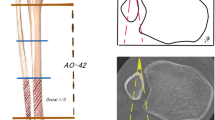Abstract
Introduction
High tibial osteotomy (HTO) is an important treatment alternative in isolated single compartment knee osteoarthritis. To achieve adequate mechanical axis corrections in the lower extremity fibula is also osteotomized concomitantly. The aim of this study was to compare the union rates of proximal and diaphyseal fibular osteotomies accompanying high tibial osteotomies.
Method
Sixty-seven knees of sixty-three patients who had undergone HTO were retrospectively evaluated. The patients were grouped according to the level of the fibular osteotomy (FO). In group I, the level of FO was proximal, and in group II, it was at the level of junction of middle and distal third of diaphysis. The union rates of FOs at two different levels were compared. The influence of the presence of displacement at the osteotomy site and apposition between bone ends on union was also evaluated.
Results
Fifty-nine of sixty-seven FOs (88.06 %) were united. The union rate of proximal FOs was significantly greater than diaphyseal osteotomies (p < 0.0001); 97.9 % of proximal FOs were united, whereas this ratio was 65 % for the diaphyseal FOs. The presence of displacement at the FO and apposition between bone ends significantly influenced the bony union rate (p values 0.035 and <0.0001, respectively).
Conclusion
Union rates and nonunion characteristics of FO might differ according to its level, apposition of bone ends, and contact area. The fate of FO might also affect the union of HTO.


Similar content being viewed by others
References
Jackson JP, Waugh W (1960) Tibial osteotomy for osteoarthritis of the knee. Proc R Soc Med 53(10):888
Jackson JP, Waugh W (1961) Tibial osteotomy for osteoarthritis of the knee. J Bone Jt Surg Br 43-B:746–751
Petersen W, Wall A, Paulin T, Park HU, Heymann L (2014) Stability of two angular stable locking plates for open wedge high tibial osteotomy (HTO): TomoFix™ versus LOQTEQ® HTO plate. Arch Orthop Trauma Surg 134(10):1437–1442
Arun GR, Kumaraswamy V, Rajan D, Vinodh K, Singh AK, Kumar P et al (2016) Long-term follow up of single-stage anterior cruciate ligament reconstruction and high tibial osteotomy and its relation with posterior tibial slope. Arch Orthop Trauma Surg 136(4):505–511
Aydogdu S, Yercan H, Saylam C, Sur H (1996) Peroneal nerve dysfunction after high tibial osteotomy. An anatomical cadaver study. Acta Orthop Belg 62:156–160
Cobanoglu M, Cullu E (2014) Cerrahi uygulamada önemli etmenler. In: Sur H (ed) Yüksek tibial osteotomi, 1st edn, Turkish Society of Orthopedics and Traumatology, Miki Press, Ankara, pp 65–68 (Article in Turkish)
Jokio PJ, Ragni P, Lindholm TS (1986) Management of the fibula in high tibial osteotomy for arthritis of the knee. Union times and complications. Ital J Orthop Traumatol 12(1):41–52
Kurosaka M, Tsumura N, Yoshiya S, Matsui N, Mizuno K (2000) A new fibular osteotomy in association with high tibial osteotomy (a comparative study with conventional mid-third fibular osteotomy). Int Orthop 24(4):227–230
Wootton JR, Ashworth MJ, Macla CA (1995) Neurological complications of high tibial osteotomy—the fibular osteotomy as a causative factor: a clinical and anatomical study. Ann R Coll Surg Engl 77:31–34
Billings A, Scott DF, Camargo MP, Hofmann AA (2000) High tibial osteotomy with a calibrated osteotomy guide, rigid internal fixation, and early motion. Long-term follow-up. J Bone Jt Surg Am 82(1):70–79
Curley P, Eyres K, Brezinova V, Allen M, Chan R, Barnes M (1990) Common peroneal nerve dysfunction after high tibial osteotomy. J Bone Jt Surg Br 72(3):405–408
Ogbemudia AO, Umebese PF, Bafor A, Igbinovia E, Ogbemudia PE (2010) The level of fibula osteotomy and incidence of peroneal nerve palsy in proximal tibial osteotomy. J Surg Tech Case Rep 2:17–19
Soejima O, Ogata K, Ishinishi T, Fukahori Y, Miyauchi R (1994) Anatomic considerations of the peroneal nerve for division of the fibula during high tibial osteotomy. Orthop Rev 23:244–247
Ramanoudjame M, Vandenbussche E, Baring T, Solignac N, Augereau B, Gregory T (2012) Fibular nonunion after closed-wedge high tibial osteotomy. Orthop Traumatol Surg Res 98(8):863–867
Author information
Authors and Affiliations
Corresponding author
Ethics declarations
Conflict of interest
The authors declare that they have no conflict of interest.
Rights and permissions
About this article
Cite this article
Bicer, E.K., Basa, C.D., Gunay, H. et al. The fate of fibular osteotomies performed during high tibial osteotomy. Arch Orthop Trauma Surg 136, 1085–1090 (2016). https://doi.org/10.1007/s00402-016-2493-x
Received:
Published:
Issue Date:
DOI: https://doi.org/10.1007/s00402-016-2493-x




